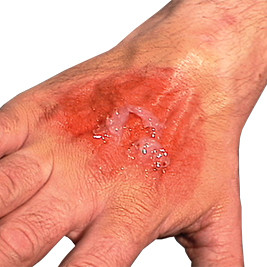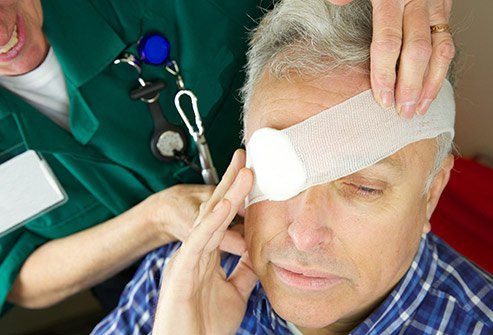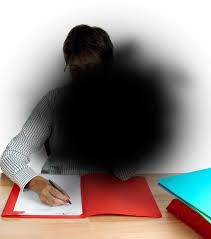Definisi
Luka bakar dapat terjadi pada mata, khususnya kornea. Berdasarkan penyebabnya, luka bakar ini dapat dibagi menjadi luka bakar kimia dan luka bakar termal. Luka bakar kimia pada umumnya disebabkan oleh zat kimia asam kuat atau basa kuat yang terciprat ke mata. Sementara itu, luka bakar termal merupakan luka bakar yang disebabkan oleh panas. Di antara kedua jenis luka bakar ini, luka bakar kimia lebih sering terjadi.
Penyebab
Luka bakar kimia pada umumnya disebabkan oleh zat kimia asam kuat atau basa kuat. Zat kimia tersebut dapat merupakan benda-benda rumah tangga yang lazim ditemukan, seperti pembersih pipa atau oven, deterjen, pemutih, atau amoniak. Zat kimia lainnya yang dapat menyebabkan luka bakar dapat berupa pupuk, asam yang digunakan di pabrik, larutan alkali, kapur, dan semen. Luka bakar ini biasanya terjadi secara tidak sengaja, akibat terciprat, tersemprot, atau mengucek mata.
Luka bakar kimia akibat basa biasanya akan lebih parah daripada asam. Hal ini disebabkan oleh sifat basa yang mudah menempel pada lemak, sementara lemak merupakan lapisan utama yang melindungi mata. Tidak hanya itu, jaringan yang rusak akibat basa dapat mengeluarkan zat yang merusak protein dalam jaringan, sehingga menyebabkan kerusakan lebih parah. Sementara itu, pada luka bakar yang disebabkan oleh asam, asam menyebabkan kerusakan protein. Kerusakan protein ini menyebabkan penggumpalan, yang selanjutnya mencegah asam masuk lebih jauh ke dalam jaringan.
Sementara itu, luka bakar akibat panas dapat terjadi akibat benda sehari-hari, seperti minyak pada saat memasak, ledakan rokok elektronik, busur listrik, atau luka hangus. Benda-benda seperti kembang api dan petasan memiliki kemungkinan untuk menyebabkan luka bakar kimia dan termal sekaligus.
Faktor Risiko
Luka bakar kimia dan termal berisiko lebih tinggi untuk terjadi pada pria muda dan anak-anak berusia 1-2 tahun. Pria muda seringkali terpapar zat ini pada saat bekerja di rumah, pabrik, ataupun merokok. Anak-anak dapat terpapar oleh zat kimia dan tidak sengaja mengucek mata.
Gejala
Pada luka bakar, keluhan yang biasa muncul adalah nyeri yang luar biasa, mata berair, kekakuan otot kelopak mata, dan penurunan tajam penglihatan. Hal ini biasanya terjadi setelah terciprat zat kimia, mengucek mata, atau terkena panas.
Diagnosis
Diagnosis luka bakar dapat dilakukan sendiri berdasarkan riwayat. Dokter biasanya akan menanyakan riwayat dan kronologi kejadian terjadinya luka bakar secara singkat. Jika luka bakar disebabkan oleh zat kimia, dokter akan mengalirkan cairan infus ke mata sambil memantau keasaman permukaan bola mata dengan kertas lakmus. Jika pH sudah mendekati normal, barulah dokter akan memeriksa bola mata. Pertama, dokter akan menegakkan apabila bola mata pecah atau tidak. Jika pecah, dokter akan merujuk Anda untuk pembedahan. Jika tidak pecah, dokter akan melakukan pemeriksaan untuk mengecek adanya benda asing atau sisa-sisa jaringan di mata. Pemeriksaan ini dapat menggunakan zat pewarna untuk memperjelas adanya kerusakan jaringan pada kornea. Pemeriksaan slit lamp juga akan dilakukan untuk mencari kerusakan pada bagian dalam bola mata. Tidak hanya itu, pemeriksaan luar seperti tajam penglihatan dan tekanan bola mata akan dilakukan.
Pada luka bakar akibat panas, dokter akan mengalirkan cairan infus ke mata sebelum melakukan pemeriksaan lanjutan. Dokter akan menanyakan pula kronologi kejadian trauma, dan jika melibatkan ledakan, dokter akan memeriksa mata untuk mencari adanya partikel-partikel kecil yang menempel atau menembus mata. Pemeriksaan untuk mencari adanya trauma di bagian tubuh lainnya juga diperlukan untuk mencegah komplikasi.
Tata Laksana
Tata laksana awal untuk luka bakar dapat diusahakan sendiri sebelum sampai IGD. Pertolongan pertama yang terpenting adalah mengaliri mata dengan air bersih untuk menetralkan zat kimia atau panas. Perlu diperhatikan bahwa sebaiknya jangan menggunakan zat kimia asam atau basa untuk menetralkan zat kimia, karena dapat menyebabkan kerusakan lebih parah.
Cara mengaliri mata adalah sebagai berikut:
- Isi baskom dengan air bersih dingin
- Masukkan wajah Anda ke dalam baskom hingga menyentuh air
- Buka dan tutup mata secara berulang untuk memastikan air menyentuh seluruh bagian dari permukaan mata
- Lakukan hal ini selama 20-30 menit sambil menuju ke IGD. Jika tidak memungkinkan, prioritas tertinggi adalah mengaliri mata dengan air bersih
- Selain menggunakan baskom, Anda dapat meminta bantuan orang lain untuk mengalirkan air bersih mengalir dengan selang kecil
- Alirkan air dari arah hidung ke luar
- Selama air dialirkan, berkediplah dan gerakkan bola mata ke seluruh arah untuk memastikan seluruh permukaan mata teraliri
- Sama seperti cara sebelumnya, hal ini dapat dilakukan selama 20-30 menit atau lebih
Di IGD, dokter biasanya akan mengaliri mata Anda dengan cairan infus setelah diberikan bius lokal. Dokter juga dapat menggunakan alat untuk menahan mata agar tetap terbuka. Biasanya, dokter akan mengaliri mata selama 30 menit menggunakan 1-3 L air sampai tingkat keasaman di mata netral, yang diukur menggunakan kertas lakmus. Dokter juga akan mengalirkan air ke dalam kelopak mata untuk memastikan seluruh permukaan mata teraliri air.
Setelah tingkat keasaman menjadi netral, dokter dapat meresepkan beberapa obat. Antibiotik perlu diberikan untuk mencegah infeksi yang lebih rentan terjadi akibat kerusakan struktur permukaan mata. Pemberian obat pelemas otot penglihatan dapat digunakan untuk melegakan nyeri. Selain itu, dokter dapat memberikan tetes air mata buatan untuk melembapkan permukaan mata dan melegakan nyeri. Steroid dapat pula diberikan untuk menurunkan reaksi radang seperti pembengkakan dan kerusakan kornea lebih lanjut. Penggunaan obat-obatan ini harus menggunakan resep dokter karena ada beberapa obat yang tidak boleh diberikan berlebihan.
Pada kasus parah, dokter IGD dapat merujuk Anda ke dokter spesialis mata untuk dilakukan pembedahan. Pembedahan ini dapat dilakukan untuk mencegah kerusakan lebih lanjut atau untuk memperbaiki penyembuhan.
Komplikasi
Komplikasi yang dapat terjadi bermacam-macam. Glaukoma dapat terjadi terutama pada luka bakar yang parah, akibat adanya gangguan aliran cairan pada bola mata bagian depan. Selain itu, kerusakan jaringan dapat menyebabkan mata kering akibat produksi air mata yang menurun. Kerusakan-kerusakan ini dapat pula mempengaruhi kelopak mata dan lapisan konjungtiva, yaitu lapisan bening yang melapisi bola mata dan kelopak mata bagian dalam.
Pencegahan
Luka bakar kimia dan termal sulit untuk dicegah pada kondisi sehari-hari, namun dapat dicegah pada keadaan berisiko tinggi. Gunakan kacamata pelindung saat bekerja dengan bahan kimia dan logam, karena pekerjaan ini sangat berisiko melukai mata.
Kapan Harus ke Dokter?
Segeralah ke dokter jika Anda mengalami gejala sebagai berikut setelah terpapar panas atau zat kimia:
- Pandangan ganda atau menurun yang tidak hilang dengan berkedip
- Nyeri pada mata
- Tidak nyaman saat melihat ke sumber cahaya
- Sensasi benda asing pada mata
- Mata merah, bengkak, berkedut, berair, atau bernanah
- Gejala di atas terjadi selama lebih dari 24 jam
- Gejala di atas terjadi terlalu sering atau semakin parah
Mau tahu lebih lanjut seputar penyakit-penyakit lainnya? Cek di sini, ya!
- dr Ayu Munawaroh, MKK
Bates, A., & Zanaboni, A. (2021). Ocular Burns. Retrieved 24 October 2021, from https://www.ncbi.nlm.nih.gov/books/NBK459221/.
Seltman, W. (2020). Eye Burns/Corneal Burns Treatment. Retrieved 24 October 2021, from https://www.webmd.com/first-aid/corneal-flash-burns-treatment.
Trief, D., Woodward, M., Murchison, A., Auran, J., & Syed, Z. (2021). Chemical (Alkali and Acid) Injury of the Conjunctiva and Cornea - EyeWiki. Retrieved 24 October 2021, from https://eyewiki.aao.org/Chemical_(Alkali_and_Acid)_Injury_of_the_Conjunctiva_and_Cornea.












